Introduction
Corn is the most widely adapted cereal in the world. In Mexico it is cultivated in all the states of the Republic. Despite its large area of adaptation, grain production is seriously affected in quantity and quality by unfavorable environments of climate, management, insects, diseases, weeds, and soil type (Shaw, 1988; Ortega et al., 2013).
Corn cultivation ranks second in importance in northern Tamaulipas. In the autumn-winter (OI) 2016-2019 cycles, on average, 123 thousand hectares of white and yellow grain corn were harvested annually, obtaining a production of 781 thousand tons with an average yield of 6.4 t ha-1 (SIAP, 2019). In this agricultural cycle, the presence of unfavorable biotic and abiotic factors for the crop is frequent, severely affecting its yield and quality of the grain, which is sometimes unfit for human consumption due to its high aflatoxin content. During the agricultural cycle O-I 2019-2020 conditions of precipitation, temperature, winds, and pests, which negatively affected the crop, for which various organisms and producers requested a technical opinion from INIFAP-Campo Experimental Río Bravo (CERIB) on such situation. Therefore, the objective of this document is to make a diagnosis of the causes that affected the yield and quality of corn grain in the north of Tamaulipas.
Methodology
To determine the probable causes that affected the yield and quality of the corn grain, the following were used: 1) The review of the climatic temperature records from April 20 to June 10, 1988-1994 (Rodríguez et al., 1995) , 2) Visits and data collection of corn trials established in batches of cooperating growers in Díaz Ordaz, Río Bravo, Tamaulipas and to trials planted at CERIB, 3) Talks and interviews with growers and technical advisers and 4) Literature consultation and information from trials established in previous years.
Diagnosis
The factors that were considered to make this diagnosis were: temperature, wind, rainfall, pests, and diseases, which are described below.
Temperature. Temperature has a fundamental role in the development, growth, and yield in the corn crop (Agroconsultas Online, 2015; Noriega, et al., 2011). In Figure 1, the maximum and minimum temperatures recorded in the region are shown, it can be seen in the vegetative stage of the plant (from day 20 to 102), the crop was subjected to sudden changes in temperature in very short periods, from overnight, which could cause physiological disorders to the plant, affecting its growth and development.
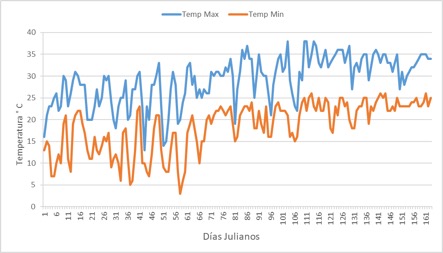
On February 27, temperatures very close to freezing (3° C) were recorded in some areas of the region, accompanied by strong dry winds from the north, causing damage and loss of foliage in corn plants, being the most affected those sown in mid-January, since they were in stages V5 to V6 (Figure 2). The loss of foliage and the physiological disorder due to this drop in temperature could have a negative impact on the crop (Pioneer; Nielsen, 2019).
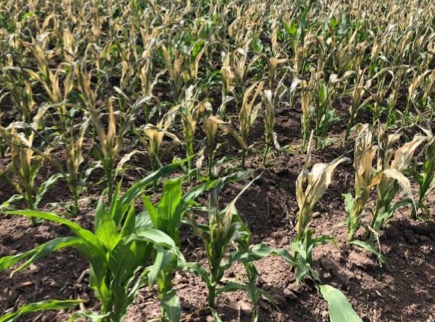
The reproductive stage of the crop, which includes flowering, grain filling and physiological maturity, occurred around April 20 to June 10, when the plant was at its maximum photosynthetic activity, the average maximum and minimum temperatures of this period were 33.5° and 23.1 ° C, respectively, which are above the optimum for corn, between 21° and 32 ° C, (Shaw, 1988). In this region of the state, it has been found that the average minimum (night) temperature that can be reached in the period from April 20 to June 10 is 22 ° C, as the temperature increases the yield decreases, in some cases it can reach up to 20%, as it happened in 1989 (Reyes, 1990).
Night temperatures, those with the greatest negative effect on yield, cause the reproductive stage of corn to be shortened, since the plant has less time to fill grain (Jeschke et al., 2018). The crop consumed more energy in respiration, resulting in a lower number of grains and a lower specific weight of the same. The sowing dates most affected by high temperatures are those made after February 10, close to the close of the sowing date, as well as those made outside the authorized period, which includes from January 20 to February 15 (Cantú et al., 2010).
In the north of Tamaulipas, there are frequent years in which day and night temperatures are registered above the optimal ones for the cultivation of corn in the reproductive season, which prevents that in this region yields higher than 12 t ha1 are achieved, such as those registered in Sinaloa and Guanajuato (Reyes and García, 1996).
Wind. In the first decade of May, when most of the corn sowings were in grain filling, strong winds (of more than 70 km per hour) appeared, accompanied by rain, causing severe damage to the lodging, mainly in the riparian region (Figure 3). The damage was greater in properties that provided them with relief irrigation or that had just been irrigated. The lodging damage suffered by the crop, the humidity, and the warm temperatures, favored the development of the weeds, making the harvest difficult, as can be seen in Figure 4. In addition, the environment in which the ears were located was conducive to them being severely damaged. by fungi, insects, and rodents (Figure 5).
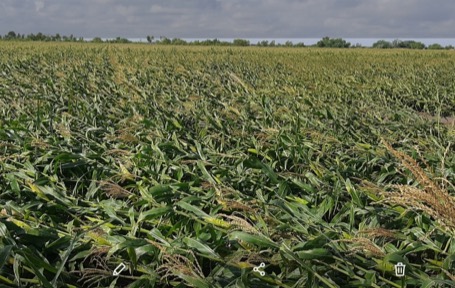
Figure 3. Severe lodging damage observed in a plot in the municipality of Díaz Ordaz, Tam. 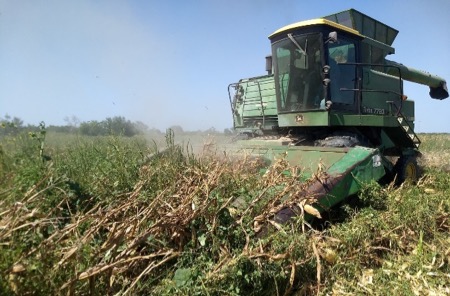
Figure 4. Weeds made the harvest difficult, leaving serious yield losses on some farms. (Photo courtesy: Ing. Gustavo Chavana). 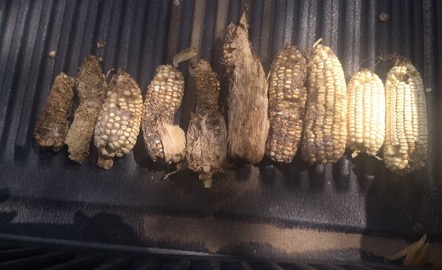
Figure 5. Cobs with damage from fungi, insects and rodents, collected in the lot that appears in Figure 4. (Photo courtesy: Ing. Gustavo Chavana).
Precipitation. In the months of February to April, little isolated rainfall was registered in the region, so the crop did not receive additional water to that of the irrigations. Those properties to which the aid irrigation was not applied in number and opportunity suffered drought stress. At the end of March and during the first fortnight of April, it is important that the crop does not suffer drought stress since this is when the corn plant (vegetative stage of V6-V8), determines the number of rows of corn on the cob that will form (Castellanos et al., 2019; Strachan, 2004). In the Control Irrigation District, in the OI 2019-2020 cycle there were water limitations for irrigation, so it is possible that in some lots the three relief irrigations were not provided, as well as at the appropriate time required cultivation.
Plagues and diseases. The conditions of high temperatures and drought favored a high incidence of ear pests such as fall armyworms (Spodoptora frugiperda, Lepidoptera: Noctuidae) and corn (Helicoverpa zea). It is shown that these insects cause severe damage to the ear and facilitate the entry of fungi (Cantú et al., 2010; Rodríguez et al., 2010). The most affected lots were those established at the end of the authorized sowing season, February 15. Its high presence made it difficult to control (Figure 6). The damage caused by insects to the leaves of the ear (totomoxtle) and the rainfall recorded at the end of May and the first half of June (93.5 mm), as the crop approached maturity, reached the ear, favoring rotting of the grain caused by fungi, mainly of the genus Fusarium and to a lesser degree, Aspergillus and Penicillium (Figure 7).
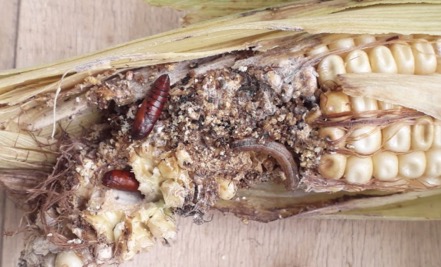
Figure 6. High infestation of fall armyworm larvae and pupae in a batch sown on February 14. Photo Courtesy: Dr. Enrique Rosales Robles. 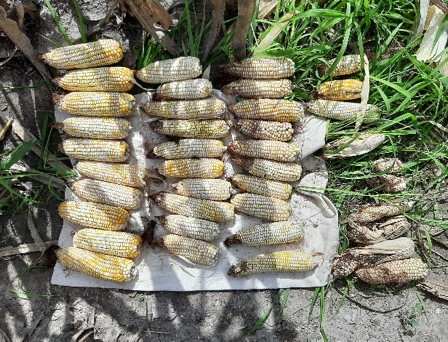
Figure 7. Damage caused by armyworm and corn larvae as well as fungi in a field sown on February 14.
Conclusion
There are several factors that lowered the corn grain yield, probably the one with the greatest impact being the high nighttime temperatures observed during the grain filling period, since these were recorded throughout the northern region of Tamaulipas. Damage caused by winds, rain, insects, diseases, weeds, low temperatures, late sowing dates and difficulty in harvesting due to lodging, as well as the application in the number and timing of relief irrigations were in some areas, therefore that the degrees of impact on the performance of the lots are variable and difficult to quantify, since they depend on their location and agronomic management received.
On the other hand, the results of the yield tests established in this agricultural cycle agree with the works reported by Cantú et al., 2010; Reyes and García, 1996 and Rodríguez et al., 1995, that is, the crops least affected in yield and grain quality by biotic and abiotic factors, were those that applied in a timely manner the technological package recommended by INIFAP, (INIFAP, 2017), so it is suggested to apply this technology in a timely manner.
